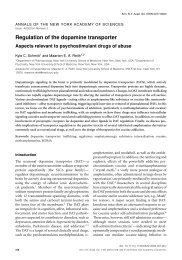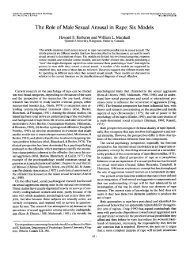Manipulation of frontal EEG asymmetry through biofeedback alters ...
Manipulation of frontal EEG asymmetry through biofeedback alters ...
Manipulation of frontal EEG asymmetry through biofeedback alters ...
Create successful ePaper yourself
Turn your PDF publications into a flip-book with our unique Google optimized e-Paper software.
690 J.J.B. Allen, E. Harmon-Jones, and J.H. Cavender<br />
Facial Muscle Activity During Films<br />
Z-transformed EMG scores were analyzed in a Training Direction<br />
Day ~pre, post! Muscle Region ~zygomatic, corrugator! <br />
Film Valence ~happy, neutral, sad! repeated measures ANOVA. As<br />
a validity check, the Film Valence Muscle Region interaction was<br />
significant, F~2,32! 18.45, p .001, G-G corrected, providing<br />
support that facial EMG is sensitive to emotional valence. Planned<br />
comparisons indicated that zygomatic activity was greater, p .01,<br />
during the positive film ~mean Z .52! than the neutral film ~mean<br />
Z .21! or negative films ~mean Z .30! the latter not differing<br />
~ p .65! from one another. Corrugator activity, by contrast,<br />
was significantly greater, p .001, during the sad film ~mean Z <br />
.62! than during the neutral ~mean Z .29! or happy films ~mean<br />
Z .33! the latter not differing ~ p .85! from one another.<br />
The hypothesized Direction Time Muscle-Region interaction<br />
was significant, F~1,16! 6.82; p .05 ~see Figure 3!, but<br />
this was not moderated by a higher order four-way interaction with<br />
Figure 3. Muscle activity in the zygomatic and corrugator regions during<br />
film viewing, before and after bi<strong>of</strong>eedback training. Participants trained<br />
RIGHT ~shaded bars! evidenced significantly less zygomatic activity as a<br />
function <strong>of</strong> training, whereas participants trained LEFT ~open bars! evidenced<br />
significantly less corrugator activity as a function <strong>of</strong> training.<br />
Film Type, F~2,32! .57, ns. Planned comparisons indicated that<br />
whereas RIGHT participants produced less, p .01, zygomatic<br />
~“smile”! activity following training, LEFT participants produced<br />
less, p .05, corrugator ~“frown”! activity following training;<br />
RIGHT participants demonstrated no change in corrugator activity,<br />
whereas LEFT participants demonstrated no change in zygomatic<br />
activity. Thus training decreased muscle activity typically associated<br />
with positive affect in the RIGHT participants, while decreasing<br />
the muscle activity associated with negative affect in the LEFT<br />
participants.<br />
Exploring How Emotion and EMG Effects Appear in the<br />
Absence <strong>of</strong> Day 5 Training Differences<br />
The finding that self-reported emotion and facial EMG on Day 5<br />
differed as a function <strong>of</strong> training direction, in the absence <strong>of</strong><br />
significant differences in <strong>EEG</strong> <strong>asymmetry</strong> between groups on<br />
Day 5, is somewhat puzzling and motivated exploratory analyses.<br />
Despite significant overall training effects, some participants did<br />
not respond especially strongly to the training. For these exploratory<br />
analyses, only participants who showed changes in the expected<br />
direction as a function <strong>of</strong> training ~i.e., “responders”! were<br />
examined. Operationally, all <strong>asymmetry</strong> scores ~five blocks and<br />
5 days! were summed, and participants were divided into those<br />
above and below the median ~median .038!. These <strong>asymmetry</strong><br />
scores had been baseline adjusted ~see above! prior to this summation,<br />
so that these scores reflected not trait differences between<br />
participants, but movement from each participant’s own baseline.<br />
When classified in this manner, 5 <strong>of</strong> the LEFT participants were<br />
above the median, and 5 <strong>of</strong> the RIGHT participants were below the<br />
median. For these exploratory analyses, only these 10 participants<br />
were included.<br />
As expected, the effects <strong>of</strong> training were evident in this subsample<br />
<strong>of</strong> responders. Asymmetry scores were analyzed in a Direction<br />
~RIGHT0LEFT! Day ~1–5! Block ~1–5 within each<br />
day! repeated measures ANOVA. In the absence <strong>of</strong> any significant<br />
main effects or other interactions, a significant Direction Day<br />
interaction emerged, F~4,32! 4.11, p .01, and remained significant<br />
following Greenhouse-Geisser epsilon correction, E .69,<br />
p .05. Planned comparisons between the two groups on each day<br />
<strong>of</strong> training revealed that those participants trained RIGHT differed<br />
from those trained LEFT on Days 2, 3, 4, and 5, ps .01 ~see<br />
Figure 4!. Planned comparisons <strong>of</strong> Days 2–5 to Day 1 revealed that<br />
for participants trained RIGHT, significant training effects, p .05,<br />
emerged on Days 3, 4, and 5. For participants trained Left, a significant<br />
training effect was evident only on Day 4, p .05. Thus<br />
among participants who were selected as responders, bi<strong>of</strong>eedback<br />
training effects were evident despite reduced power. These differences<br />
did not reflect differences in trait levels, as scores had been<br />
baseline adjusted; moreover, the LEFT and RIGHT responders did<br />
not differ from one another on Day 1, but only on subsequent days<br />
<strong>of</strong> training. The important question remaining was whether these<br />
responders would show self-report and EMG effects.<br />
Self-report effects essentially replicated for these responders.<br />
Responses to each film were analyzed in a Direction ~RIGHT0<br />
LEFT! Emotion ~seven levels! Day ~pre0post training! repeated<br />
measures ANOVA. The interaction between direction, day,<br />
and emotion was <strong>of</strong> interest, as it would reflect a different pattern<br />
<strong>of</strong> emotional responding as a function <strong>of</strong> training. This interaction<br />
was significant for the happy film, F~6,48! 4.35, p .02, G-G<br />
corrected, but not for the neutral film, F~6,48! 2.00, ns, orthe<br />
sad film, F~6,48! .76, ns. Simple effects analyses for the happy<br />
film indicated that whereas there were no differences in the pattern










